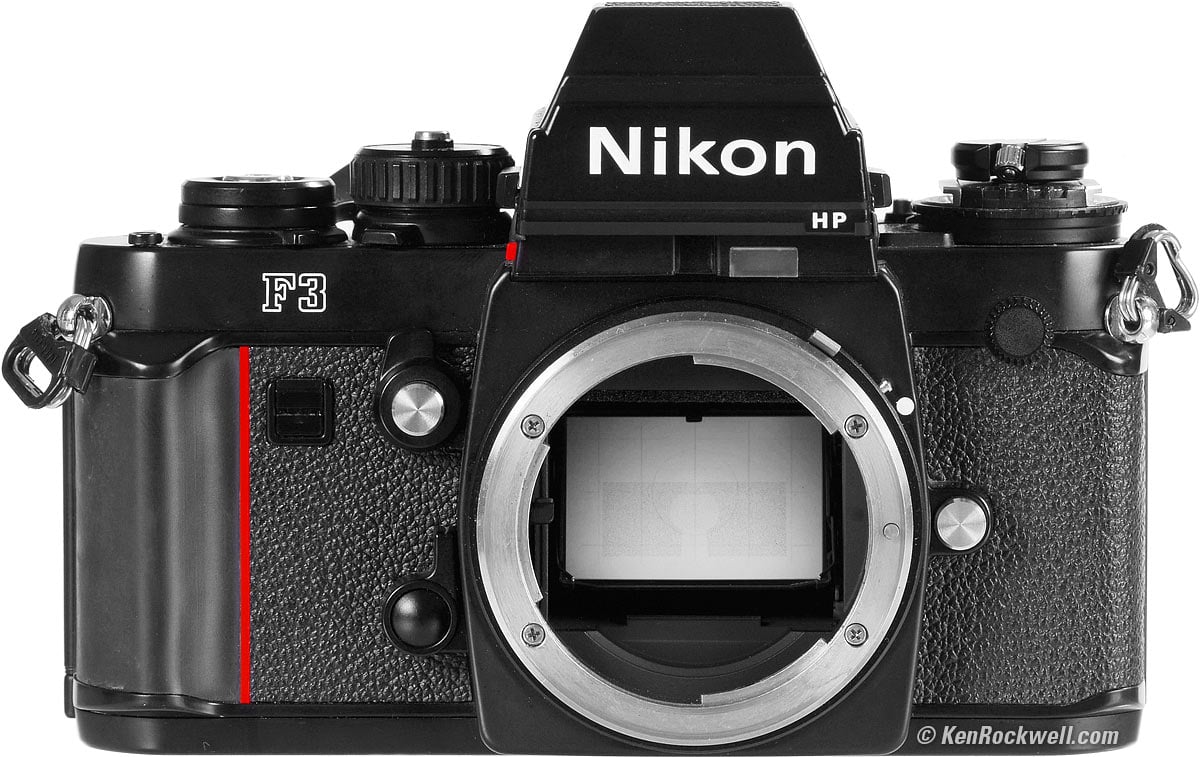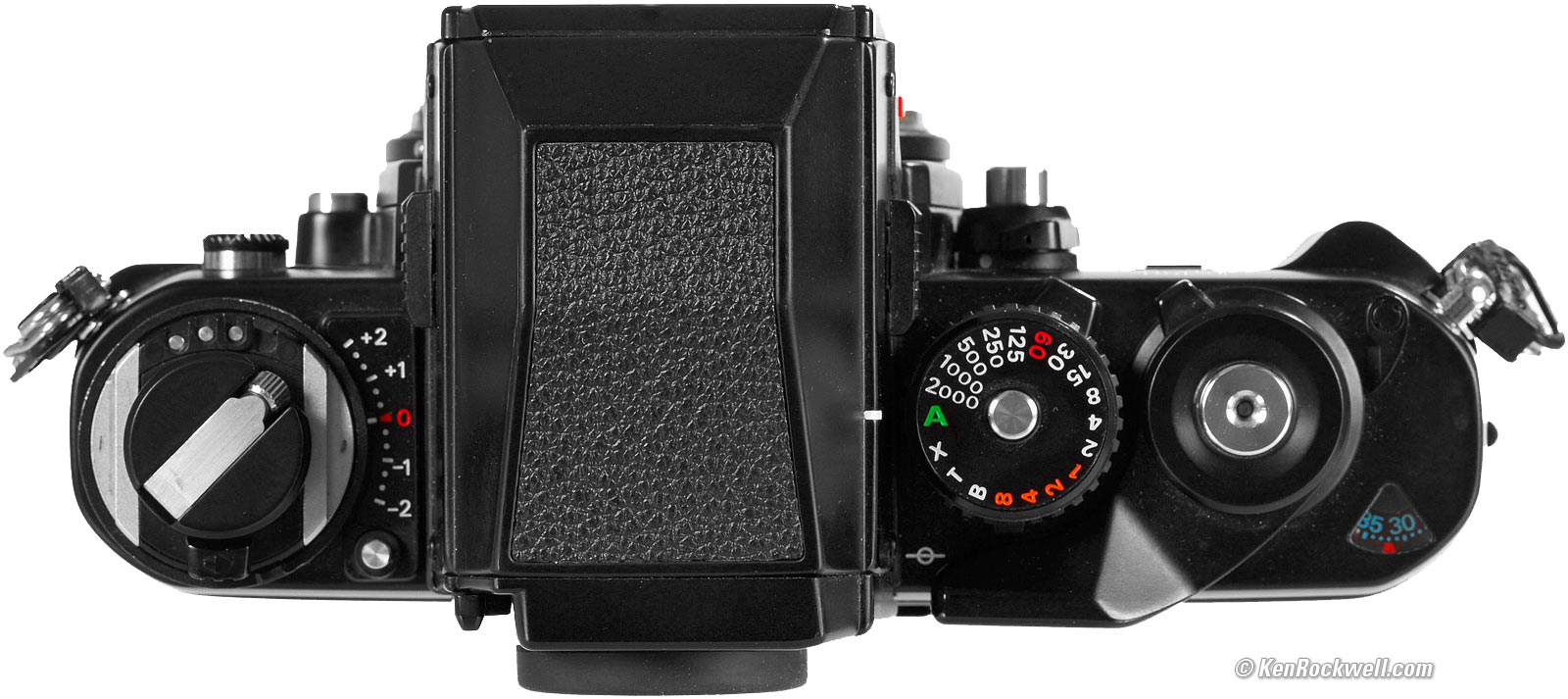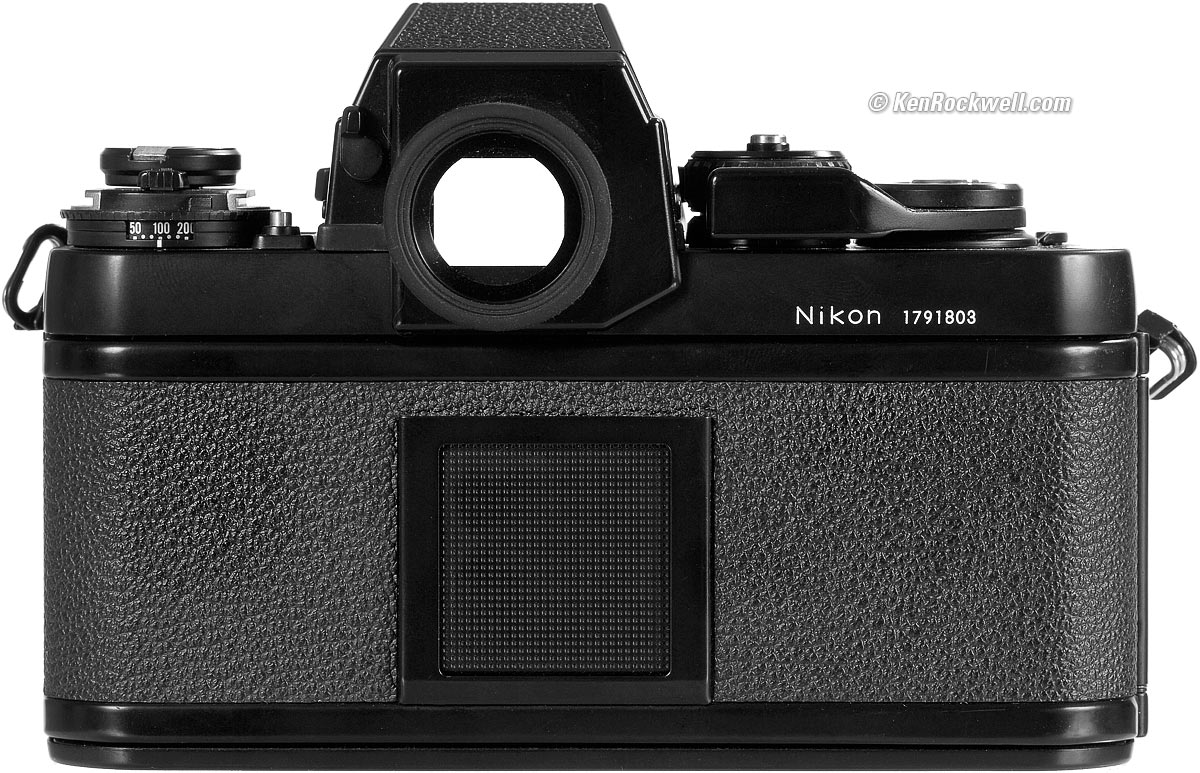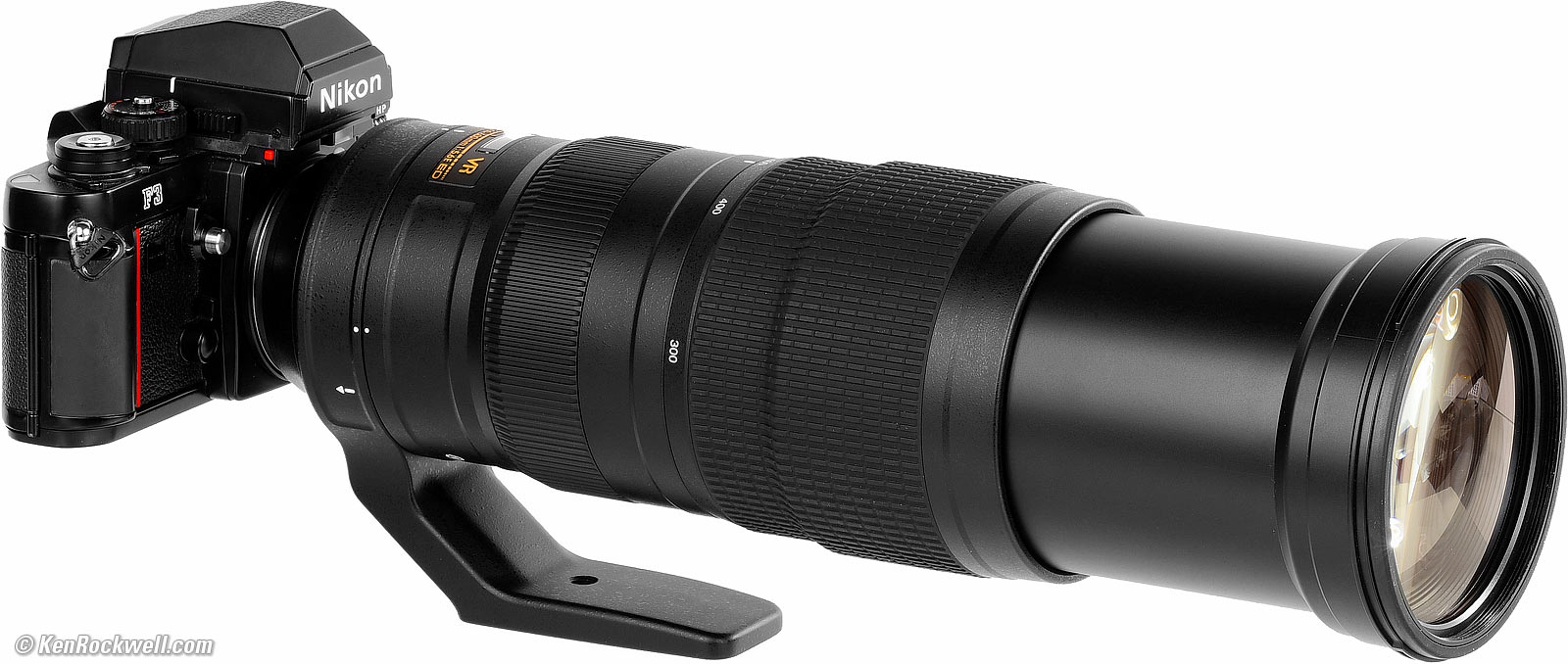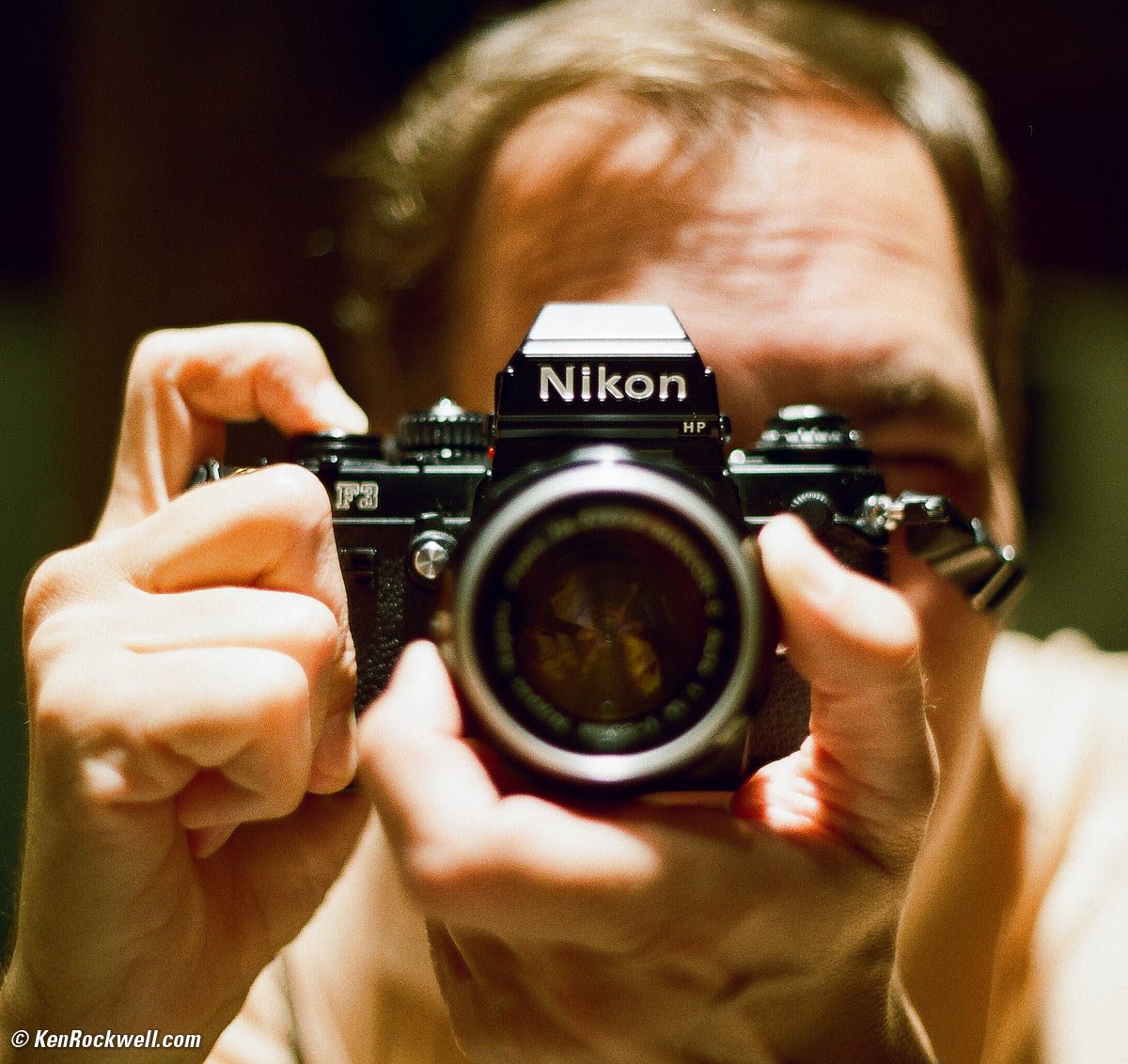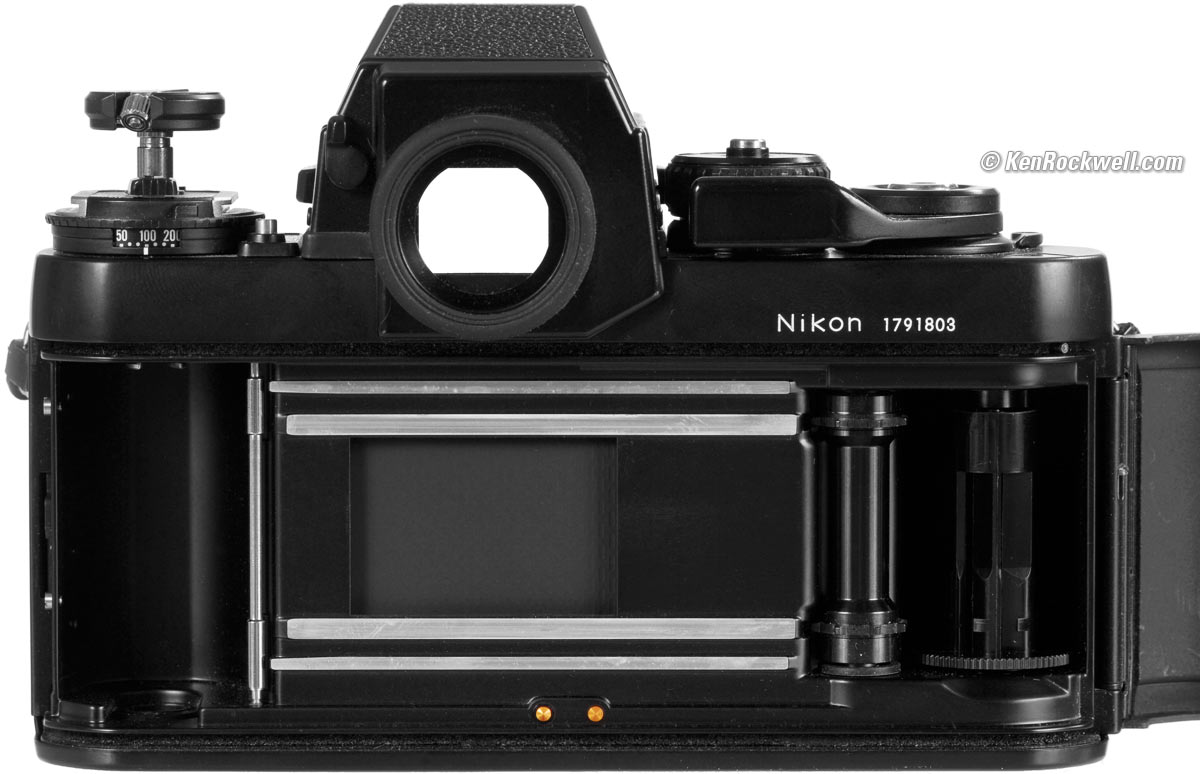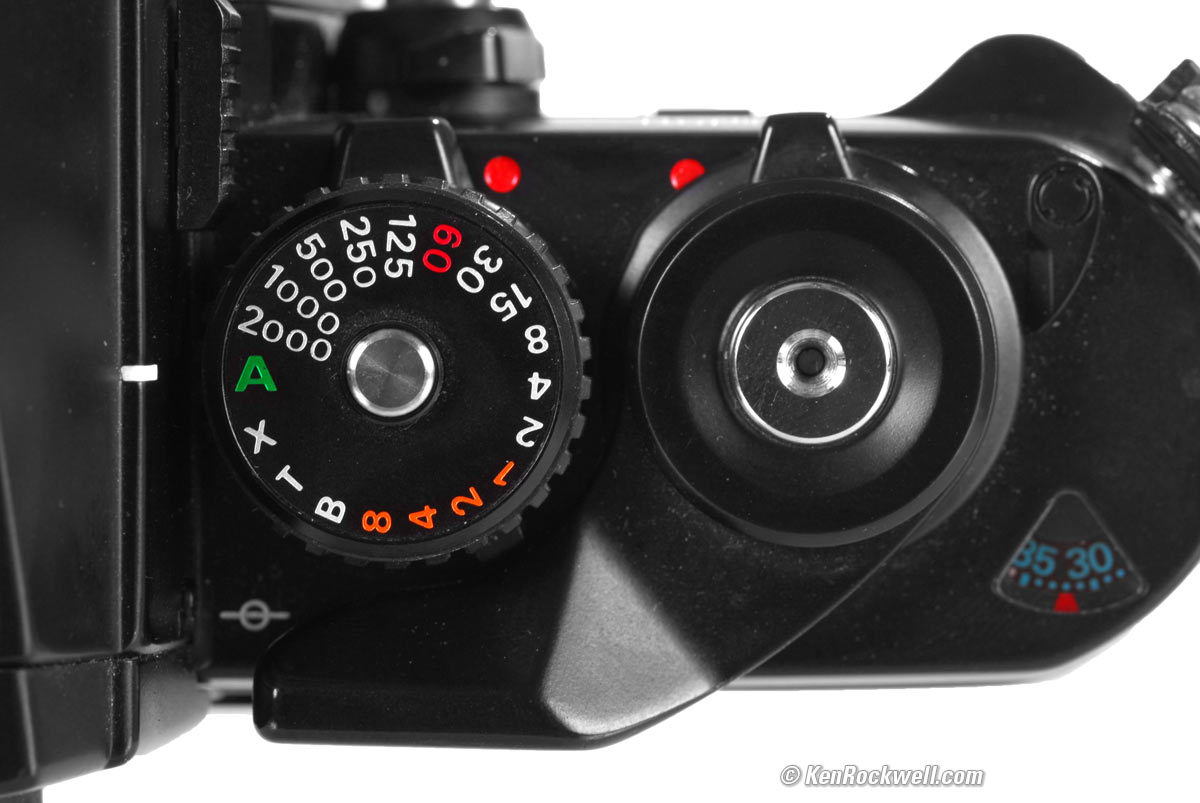Nikon F3 HP
(1980 ~ 2001)
Nikon's Lightest Professional 35mm SLR
Intro Specs Performance Usage Recommendations
Nikon F6 F5 F4 F3 F2AS F2S F2 F SP S3
Nikon F3 HP (26.9 oz./762g, takes two A76, S76, SR44 or LR44 cells, about $350 used if you know How to Win at eBay). bigger. You also can get them at Amazon.
This all-content, junk-free website's biggest source of support is when you use those or any of these links to approved sources when you get anything, regardless of the country in which you live. Thanks for helping me help you! Ken.
Great for: Inexpensive, tough professional manual-focus, auto- and manual-exposure Nikon for use with manual and most AF lenses. Great for long automatic night exposures many minutes long. The F3 works with many bizarre finders and focus screens, if you're a whacko.
Not for: No autofocus, not convenient for use with most flashes and not if you need a small camera.
May 2023 Better Pictures Nikon Reviews Nikon Lenses Nikon Flash All Reviews
Nikon F3 HP. enlarge.
Nikon F3 HP. enlarge.
Introduction top
Intro Specs Performance Usage Recommendations
|
|
The Nikon F3 has always been one of Nikon's best pro cameras. There are still plenty of people using them today. Nikon continued to make the F3 even after it introduced the F4 and the F5. It stands out for its big finder, simple and durable electronic auto exposure and manual shutter system, and its ball-bearing smooth manual film advance lever. Its MD-4 motor drive was sold separately.
The F3 remains popular as Nikon's lightest professional 35mm SLR ever made.
The F3 is manual focus only and works best with Nikon's manual focus AI and AI-s lenses made since 1977, as well as the unusual AI-P lenses, which offer the best manual-focus feel and full meter coupling.
The F3 works with older non-AI "F" manual focus lenses made since 1959, however they demand stop-down metering unless you have them AI updated.
Autofocus AF, AF-I, AF-D and AF-S lenses work fine so long as they have an aperture ring, just with scratchier manual focus. "Work fine" means metering and focus works great, but of course you'll need to focus all of these by hand. (more at Nikon Lens Compatibility.)
You'll most often see the slightly newer F3HP version shown here, recognized by the "HP" on the front of the interchangeable finder. The HP, or High Eyepoint version, has a slightly larger eyepiece with slightly less magnification so you can hold your eye slightly farther away.
Exposure is match-dot manual, or aperture-preferred auto. Metering is Nikon's classic heavily center-weighted system.
Personally I prefer the smaller size of the similarly-featured FE, but if you need interchangeable finders and screens (which you don't), the F3 is Nikon's arguably finest manual focus camera ever.
Watch my precise wording: the F3 is Nikon's finest manual-focus camera, but Nikon's best camera for use with manual-focus lenses is today's F6, which has better manual focusing and better metering when used with manual lenses. Nikon's most advanced manual-focus camera is the Nikon FA, which adds Matrix Metering and Shutter-priority and Program exposure to the FE.
I prefer the analog meter needle of the FE over the digital LCD meter of the F3. Specifically, I find it far faster and intuitive to set an exposure while watching the needle move as I survey a contrasty scene than to have to read, digest and calculate from the digital LCD of the F3.
The F3 has TTL flash, but it requires the use of bizarre adapters; heck, the F3 doesn't even have a flash shoe! Even if you use its dedicated SB-whatever-teen flash, the TTL feature is for shooting with flash only, not for calculating fill flash.
I got my F3 used at eBay (How to Win at eBay), and you also can get them at Amazon.
History
1980: F3 (DE-2 finder) introduced.
F3HP (DE-3 finder) introduced a couple of years later. It has more eye relief, but a little less magnification.
1982: F3T (titanium covers). The F3T was champagne from 1982-1985, then black.
1983: F3AF. The F3AF was Nikon's first AF SLR. It's a dead system that used a couple of dedicated lenses.
F3H: Pellicle mirror.
F3P: Militarized.
2001: End of production. I've been told that the reason that Nikon made the F3 for 21 years is because not only was it always popular because it's a great camera, that it was practical to keep making it for so long because some of it's components were also used in some other instruments that Nikon had in production for this period as well.
Specifications top
Intro Specs Performance Usage Recommendations
I got my F3 used at eBay (How to Win at eBay), and you also can get them at Amazon.
Styling and Industrial Design
Giorgetto Giugiaro.
Lens Compatibility
Optimized for Nikon's AI lenses (1977 - 1983). AI-S, AF and AF-S lenses made from 1983 through today also work flawlessly so long as they have an aperture ring.
G and AF-P lenses won't work because they have no aperture rings.
Series E lenses from decades ago work flawlessly because they also are AI-S, but modern E (Electronic diaphragm) lenses will always shoot wide-open.
Mirror lock-up allows use of old fisheye and ultrawide lenses that recessed into the body.
Press the release button and flip-up the little lever around the lens mount between the "HP" on the finder and the lens mounting index dot to use ancient non-AI lenses made from 1959 - 1977 with stop-down metering. Nikon offered AI updating for these ancient lenses to make them work just like AI.
See also Nikon Lens Compatibility.
Nikon F3 and 200-500mm f/5.6. bigger.
Finder
Removable prism and screens.
HP, High Eyepoint, finder shown here.
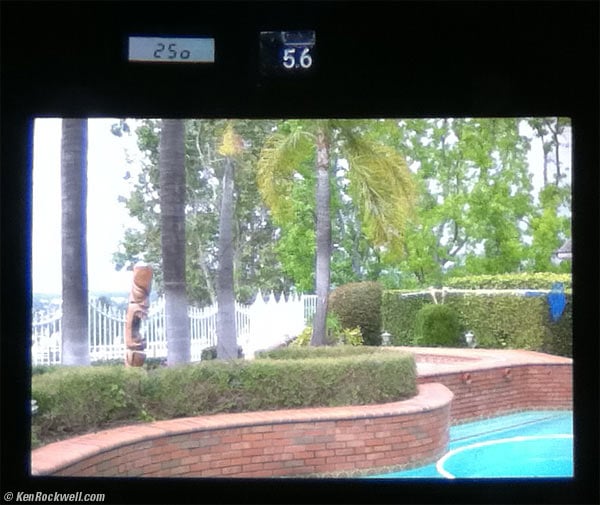
Actual photo through Nikon F3HP's finder.
Shutter speed, either manually or automatically set, is shown on the LCD at the top left. This LCD is backlit through a frosted window facing the subject, so its always lit. In the dark, a dim bulb can be turned on to help.
Aperture is shown through the ADR (Aperture Direct Readout) window top center.
Shutter
Horizontal focal plane, titanium foil.
1/80 flash sync.
1/2,000 max.
8 seconds maximum manually-set speed.
Unlimited metered, timed long exposures at least several minutes long in AUTO mode.
Bulb and Time manual modes, too.
Weight
F3 HP
26.882 oz. (762.1 g), measured F3 HP, with alkaline LR44 batteries and strap lugs, but without strap, without lens and without body cap.
F3
Rated 24.7 oz. (700g).
Power
Two common A76, S76, LR44 or a DL1/3N.
If you leave the power switch left on all the time, no problem: the meter only wakes up when the shutter is tapped.
Price, U. S. A. specifications top
May 2023
About $350 used if you know How to Win at eBay.
April 2019
About $300 used if you know How to Win at eBay.
2012
About $150 used; as much as $400 if really nice.
2007
Perfectly functional beater F3s went for $100, or ones just like new in their boxes sold for a few hundred dollars from Adorama, Amazon and eBay.
December 1988
$769 (F3), $799 (F3 HP), or $1,099 for the F3 Titanium at B&H at the time, equivalent to $1,975, $2,050 or $2,825 in 2023.
January 1987
$539 (F3), $579 (F3 HP), or $749 for the F3 Titanium at B&H at the time, equivalent to $1,440, $1,550 or $2,000 in 2023.
January 1986
$470 (F3 HP, or $640 for the F3 Titanium, and you had to call for the F3 Professional price) at B&H at the time, equivalent to $1,300 or $1,775 in 2023.
June 1983
$399 (F3) or $470 (F3 HP) at B&H at the time, equivalent to $1,200 in 2023.
(Personally, when I bought my first Nikon in January 1983, I preferred to pay more, $500, for a used F2AS because I didn't trust "electronic" cameras like this F3. We were all afraid the battery would die and leave us stranded; little did we know a set lasted for years and it was easy to carry a spare pair in our wallet.)
March 1982
$575 (F3) at B&H the time, equivalent to $1,800 in 2023.
Motor Drive
The MD-4 motor drive also powers the F3, so there's no need for S76 cells with the motor.
With the MD-4 attached, the F3's own shutter release also works. If you use the F3's release and hold it, the MD-4 waits to advance the film until you take your finger off the F3's top shutter release.
Performance top
Intro Specs Performance Usage Recommendations
I got my F3 used at eBay (How to Win at eBay), and you also can get them at Amazon.
The F3 was the top active pro camera for over 20 years. It works great.
It has all the exposure and mirror locks you need.
Power
Two A76 watch batteries last forever, and you can buy them anywhere or find them in keychain lights and noise makers.
Even as low as 2.8 Volts, the F3 still works great even though the illuminator is dead.
With low batteries, I hear a slight hissing sound during exposure.
After 28 months sitting in my F3 with almost no shooting, from 08/07 to 12/09, two new Maxell LR44 cells no longer would fire the shutter of the F3. They tested 0 to 10% on the MBT-1 tester.
Service and Repair
Nikon still had parts for the F3 in August 2007.
I've never seen an LCD go bad. They seem to last forever, unlike Nikon's initial cautions that they would be expected to need replacement every several years.
Finders
There are a zillion special purpose finders available, none of which make any sense to me.
DW-4 High Magnification Finder
I bought a DW-4 High-Magnification finder, and returned it. It claims 6x magnification, but that's 6x as in the view you get from 6x magnifier, not 6x bigger than the regular finder. I found the magnification of the 6x DW-4 finder about the same as the regular finder, but the image is reversed!
I find reversed images useless. Inverted images are OK,but not when they are reversed in only one dimension.
Pass on the DW-4
Screens
There are about two dozen different screens available.
Since they sell for so little used I've bought quite a few.
Want to know why they sell for so little? Because they are so useless!
Each screen addresses only a very narrow range of applications. If you pop-in a special screen, you'll have to pop it out as soon as you change your lens again.
The standard K screen (rangefinder, microprism and ground glass) is the most useful, and the one you get with most F3s.
Usage top
Intro Specs Performance Usage Recommendations
I got my F3 used at eBay (How to Win at eBay), and you also can get them at Amazon.
Ken in the mirror at Mangia Bene (50mm f/1.4 NIKKOR-S Auto (1967), Kodak Gold 100 at f/1.4 in AUTO). bigger.
Loading
Nikon F3 HP. enlarge.
So easy a 5-year old can do it (videos from May 2012):
Nikon F3 Controls. enlarge.
Nikon F3 HP: Self Timer and Power both ON. Muitiple-exposure lever to the upper right of shutter. enlarge.
Rotate the switch around the shutter button to show the red dot. That's the ON position.
I leave my power switch ON all the time. Months later, my batteries are still fine. The F3 only wake up if you tap the shutter button.
The same kind of rotary switch around the shutter-speed dial is the self timer. If you see red next to the shutter dial, you'll get the self timer until you rotate it to cover the red dot.
Multiple Exposures
Flip the tiny black lever above the frame counter and to the right of the shutter button.
It will stay that way, and you now can wind the shutter lever with your thumb but the film won't advance.
Depth-of-Field Preview
Nikon F3 HP. bigger.
Press and hold the top silver button on the front, near the "F3" logo.
Mirror Lockup
Press the Depth-of-Field Preview button and then rotate the lever around it towards the bottom of the F3.
You are free to use any of the old fisheye lenses that poke into the F3.
Finder LCD
The LCD is lit by through the window on the front of the F3, which is one of the reasons that the batteries last forever: there is no backlight.
In the dark, press the tiny red button on the prism with your trigger finger to light the LCD and lens' aperture ring. It doesn't work very well: the light is dim, the button is difficult to press, and the switch is usually dirty so the light flickers more than it lights up the LCD.
Power and Batteries
It's OK to leave it on all the time.
The meter only wakes up when you tap the shutter.
No Batteries?
If you have no batteries, you can still pop the shutter at the 1/80 sync speed. To do this, rotate the lower front lever down. If you need to do this for a while roll, leave the lever down between shots, otherwise, push it up when you're done.
Time exposures also work without batteries as explained next.
Time Exposures
For Time exposures, set T on the shutter dial.
Press the shutter button to start the exposure.
To stop the time exposure, cover the lens with your hand (to eliminate any vibrations) and turn shutter dial to another setting.
If you have no batteries, rotate the lower front lever down to start the exposure, and turn the shutter dial as before to stop the exposure.
To Use a G Lens
Don't bother, but as a parlour trick, you can meter and get auto exposure if you:
1.) Press aperture preview button
2.) Meter manually or use exposure lock in auto
3.) Take your picture.
This is a waste of time because you only can shoot at the tiniest aperture. If you don't use these steps to meter with the aperture stopped down, your pictures will be about seven stops underexposed.
See also Nikon's own F3 (not HP) Manual.
Recommendations top
Intro Specs Performance Usage Recommendations
I got my F3 used at eBay (How to Win at eBay), and you also can get them at Amazon.
Want one? Get one! They used to cost thousands of dollars new.
I prefer the smaller "amateur" Nikon FE that sells for even less and does the same thing without the interchangeable finders, but for the price of a used F3, you can't go wrong for a pro 35mm camera.
© Ken Rockwell. All rights reserved. Tous droits réservés. Alle Rechte vorbehalten. Alla rättigheter förbehållna. Toate drepturile rezervate. Ken Rockwell® is a registered trademark.
Help Me Help You top
I support my growing family through this website, as crazy as it might seem.
The biggest help is when you use any of these links when you get anything. It costs you nothing, and is this site's, and thus my family's, biggest source of support. These places always have the best prices and service, which is why I've used them since before this website existed. I recommend them all personally.
If you find this page as helpful as a book you might have had to buy or a workshop you may have had to take, feel free to help me continue helping everyone.
If you've gotten your gear through one of my links or helped otherwise, you're family. It's great people like you who allow me to keep adding to this site full-time. Thanks!
If you haven't helped yet, please do, and consider helping me with a gift of $5.00.
As this page is copyrighted and formally registered, it is unlawful to make copies, especially in the form of printouts for personal use. If you wish to make a printout for personal use, you are granted one-time permission only if you PayPal me $5.00 per printout or part thereof. Thank you!
Thanks for reading!
Ken.
